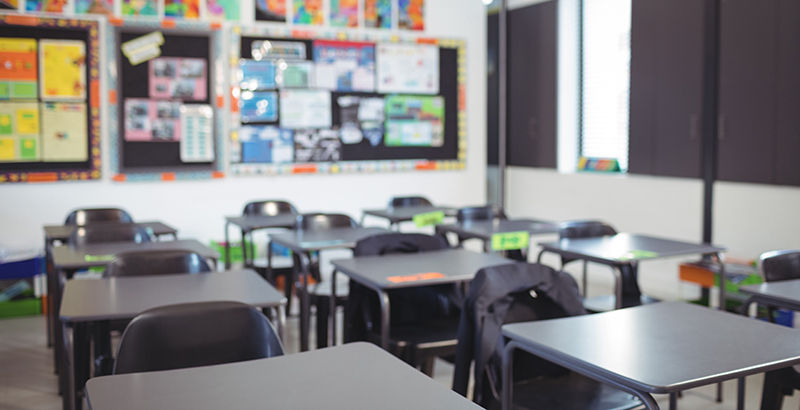Analysis: Absentee Data from 5 School Districts Show Alarming Trends that Could Disrupt Student Learning Long After COVID-19

This essay also appeared on the FutureEd blog.
Whatever you’ve heard about student absenteeism during the pandemic, it’s likely worse than you thought.
Not only are more students missing school, but they’re missing far more days than in past years — some absent as much as half the year. Younger students, who usually have better attendance rates than high schoolers, are racking up absences at unprecedented levels. And disadvantaged children, who have always faced obstacles getting to class, are recording alarmingly high rates of absenteeism. That doesn’t count the hundreds of thousands of students who aren’t even enrolled in school this year.
These trends emerged from our deep dive into attendance data from five school districts enrolling a total of nearly 450,000 students and working with EveryDay Labs attendance interventions. The spiraling rates of absenteeism are intensifying a problem that was already pervasive before the pandemic and could have devastating consequences for student learning.
As policymakers and educators explore how to spend billions in federal relief aid to help students catch up, they’ll need to include a concerted effort to turn around absenteeism if they hope to get kids back on track.
None of the strategies that schools are contemplating to close learning gaps will do much good if they don’t close attendance gaps. A 2016 study from the RAND Corp. found summer learning programs showed little impact on achievement — unless students attend at least 80 percent of the time. Likewise, extended-day programs work best for students who attend regularly, a 2007 University of California, Irvine study showed. Tutoring works best when it’s high frequency: at least 2.5 hours a week for at least 16 weeks.
We know that chronic absenteeism — missing at least 10 percent of the school year in excused or unexcused absences — is linked to weaker academic performance: A robust body of research shows a clear connection between lower grades and higher dropout rates. In that context, the current surge in absenteeism is a warning sign of further academic challenges ahead for students and schools.
Recognizing this, the U.S. Education Department is asking states to lay out how they will spend part of the $123 billion in relief funds for public schools to identify and engage students who missed the most instruction in the past two school years or who did not participate consistently in remote learning.
Fortunately, there are evidence-based interventions that can help schools address this, some of which align with other efforts to reduce the impact of lost learning time.
School districts across the country are already using home visits to reconnect with students. Connecticut is spending $10.7 million of its COVID relief money on an expanded home visiting plan in the summer and fall.
Nudges — letters and texts letting families know about their children’s absences — have proven effective in getting students back in the classroom. The Los Angeles Unified School District used the approach for a remote summer program last year and found regular communication cut down on absences among students, who were mostly from low-income Latino families.
Tutoring, which is designed to enhance academic performance, often produces the sort of caring relationships that make students want to come to school.
This speaks to the broader role of school climate initiatives in turning around absenteeism. The key to going back to school after the pandemic is making sure it feels safe, normal and expected. To achieve that, schools need to create a welcoming climate that supports students who have endured trauma.
This can be as simple as offering free breakfast or rethinking recess. It also means expanding access to counselors at school or through telehealth models. And it should involve adopting disciplinary approaches that resolve behavior outbursts without excessive suspensions. COVID relief money can go toward hiring and training staff members on these approaches.
To expand and sustain these recovery efforts, school districts should collaborate with other public agencies and community-based organizations. The local transportation department can brainstorm ways to help students get to school more easily. The health department can connect students suffering from asthma to health resources. Nonprofits and faith groups can provide volunteer tutors and mentors. Local universities can help with data analysis.
The American Rescue Plan, approved in March, specifically mentions the community schools model, which pulls together public agencies and community-based organizations to turn schools into neighborhood services hubs. The spending plan also puts $1 billion toward expanding national service programs such as AmeriCorps, meaning schools can tap more low-cost workers to serve as mentors, tutors, attendance staff and public health workers.
Undergirding all this is data analysis. Educators need to know whether they’re dealing with students who have missed 20 days of school or 100 days. They need to know why students missed out on instruction and whether the challenges persist even after the pandemic’s restrictions lift. And they need to know what works for different populations.
Ultimately, it will take the collaborative efforts of educators, families and community partners to turn around the troubling recent absenteeism trends.
Phyllis W. Jordan is editorial director of FutureEd, a think tank at Georgetown University’s McCourt School of Public Policy. Emily Bailard is chief executive officer of EveryDay Labs, which uses nudges to promote better school attendance.
Get stories like these delivered straight to your inbox. Sign up for The 74 Newsletter

